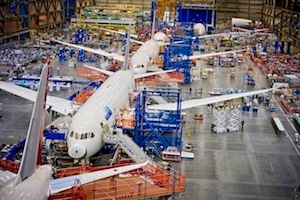April 27, 2011

Anticipatedbuild rates for the Boeing Dreamliner 787 are driving demand for fasteners.
"Demand fortitanium fastener materials is nearing its prior peak high of 2008," says William Wulfsohn,CEO of Carpenter Technology, Wyomissing, PA. "And finally, we are beginning to see order activity pick up for nickeland stainless aerospace fasteners."
TheDreamliner, a much-heralded composite-bodied aircraft,was originally scheduled to enter service in May 2008. But the project has beenbeleaguered by a myriad of design, supply chain and manufacturing problems,starting with a shortage of fasteners.
Dreamliner Production Spurs Specialty Fasteners_A |
The plane's maidenflight took place on December 15, 2009, and Boeing hopes to receive final U.S.Federal Aviation Administration flight certification this summer. The firstdelivery will be made to All Nippon Airways this fall if all goes well. Thereare currently 835 firm orders for the Dreamliner, making it one of the mostsuccessful aircraft launches of all time.
Aircraftanalysts predict that Boeing will deliver six to 18 Dreamliners this year and hopesto achieve a build rate of 10 planes a month by 2013, a record rate for awide-body jet.
Boeingcontrols production of composites through a closely monitored supply chain.Carbon fiber and epoxy prepregs come from a tight relationship with TorayIndustries, which has been rapidly ramping up capacity.
Assembly ofthe composite components requires a large number of high-quality, lightweightfasteners from suppliers such as Carpenter Technology,AlcoaFastening Systems and AlleghenyTechnologies (ATI). It's a far cry from the traditional aircraft assemblysystem in which thousands of rivets join pieces of aluminum sheet.
The 787 useseight times more titanium fasteners by weight than the 737, the aircraft hasbeen in the news recently because of apparent rivet failuresthat caused aluminum structural problems in the roofs of Southwest jets.
Demand isstronger right now for the premium fasteners used to build aircraft enginesthan for the fasteners used in assembly. Engine assembly precedes fuselageassembly.
Aircraft fastenersupplies have been negatively affected in the last three years by speculationin the supply chain. Some distributors bet on strong demand for the Dreamlinerin 2008 through 2010 and were burned when production was postponed multipletimes.
As a resultthere was a supply overhang that made it difficult for OEM suppliers to operateconsistently.
Bill Christopher,executive vice president at Alcoa, says he expectsnormal fastener demand for the 787 to resume later this year. Fasteners areclose to a billion dollar business ($868 million in 2010) at Alcoa.
ATIcurrently sells four typesof titanium fasteners for aircraft applications, and is now qualifying a fifthmaterial, ATI 425, which has strength and ductility properties making it usefulfor applications that require bending and forming.
"We continueto believe that the 787 will be one of the great innovations of our time," saysL. Patrick Hassey, CEO of ATI."We also believe that Boeing will ramp production of this airplane as fast asit can and that it will challenge the supply chain."
In yet onemore hiccup for the launch of the 787, the National Labor Relations Board(NLRB) charged in a complaint this month that Boeing was retaliating illegallyagainst its largest union when it decided in 2009 to put a second Dreamlinerassembly line in a nonunion plant in South Carolina. Boeing said it will"vigorously contest" the case and proceed with plans to start assemblingplanes in Charleston, S.C. in July.
About the Author(s)
You May Also Like






